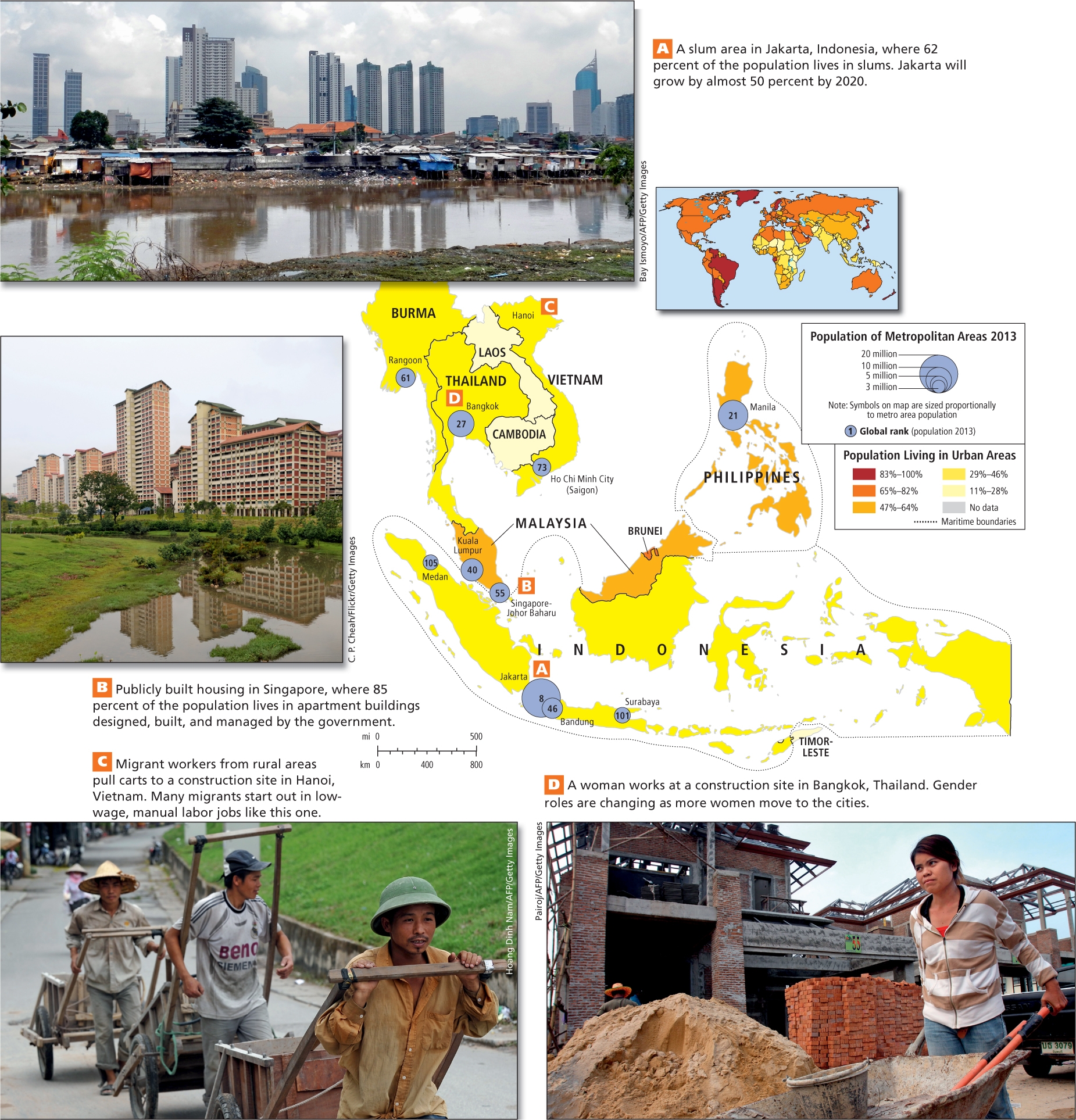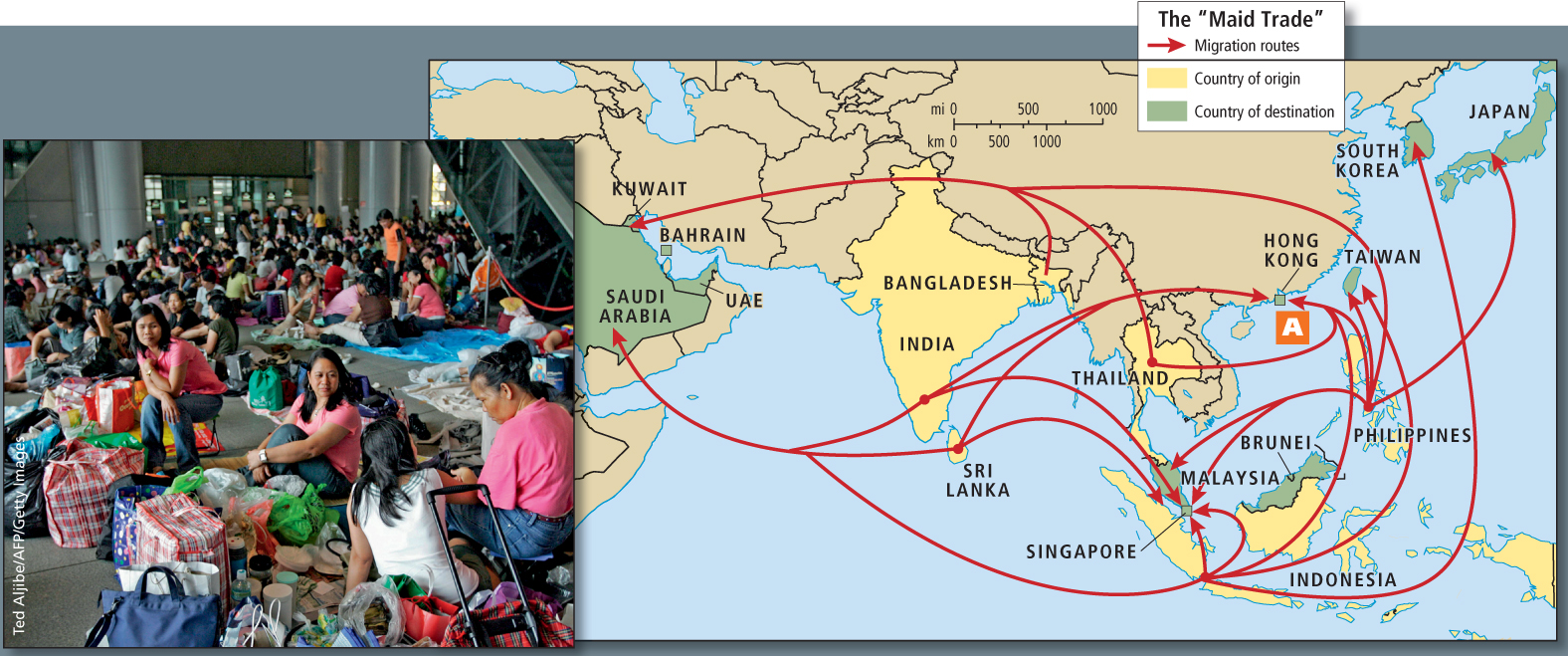10.7 URBANIZATION
GEOGRAPHIC INSIGHT 4
Urbanization: While Southeast Asia as a whole is only 43 percent urban, its cities are growing rapidly as agricultural employment declines and urban industries expand. The largest Southeast Asian cities, which are receiving most of the new rural-to-urban migrants, rarely have sufficient housing, water, sanitation, or jobs for all their people.
Page 432
Farmers who were once able to produce enough food for their families are now forced to migrate to cities, where they must purchase their food, and where the only affordable housing is in slums that lack essential services.
Southeast Asia as a whole is only 43 percent urban, but the rural–urban balance is shifting steadily in response to declining agricultural employment and booming urban industries. The forces driving farmers into the cities are called the push factors in rural-to-urban migration. They include the rising cost of farming, which is related to the use of new technologies and competition with agribusiness. Pull factors, in contrast, are those that attract people to the city, such as abundant manufacturing jobs and education opportunities. In Southeast Asia, as in all other regions, these factors have come together to create steadily increasing urbanization. Malaysia is already 64 percent urban; the Philippines, 63 percent; Brunei, 72 percent; and Singapore, 100 percent.
Employment in agriculture has been declining throughout Southeast Asia since the introduction of new production methods that increase the use of labor-saving equipment and reduce the need for human labor. Chemical pesticide and fertilizer use has also grown. While such additives can increase harvests and the supply of food to cities, they also drive the cost of production higher than what most farmers can afford. Many family farmers have sold their land to more prosperous local farmers or to agribusiness corporations and have moved to the cities. These people, skilled at traditional farming but with little formal education, often end up in the most menial of urban jobs (Figure 10.19C) and live in circumstances that do not allow them to grow their own food (see Figure 10.19A).
Figure 10.19: FIGURE 10.19 PHOTO ESSAY: Urbanization in Southeast AsiaSoutheast Asia is rapidly urbanizing as manufacturing and service sector industries pull in people from rural areas and as changes in agriculture push farmers to the cities. Many cities are struggling to cope with rapid growth.

THINKING GEOGRAPHICALLY
Use the Photo Essay above to answer these questions.
Labor-intensive manufacturing industries (garment and shoe making, for instance) are expanding in the cities and towns of the poorer countries, such as Cambodia, Vietnam, and parts of Indonesia and Timor-Leste. In the urban and suburban areas of the wealthier countries—Singapore, Malaysia, Thailand, and parts of Indonesia and the northern Philippines—technologically sophisticated manufacturing industries are also growing. These include automobile assembly, chemical and petroleum refining, and computer and other electronic equipment assembly. Riding on this growth in manufacturing are innumerable construction projects that often provide employment to recent migrants (see Figure 10.19B, D).
Cities like Jakarta, Manila, and Bangkok, among the most rapidly growing metropolitan areas in the world, are primate cities—cities that, with their suburbs, are vastly larger than all others in a country. Bangkok is more than 20 times larger than Thailand’s next-largest metropolitan area, Udon Thani; and Manila is more than 10 times larger than Davao, the second-largest city in the Philippines. Thanks to their strong industrial base and political power and the massive immigration they attract, primate cities can dominate whole countries; and in the case of Singapore, the city constitutes the entire country.
Rarely can such cities provide sufficient housing, water, sanitation, or decent jobs for all the new rural-to-urban migrants. Many millions of urban residents in this region live in squalor, often on floating raft-villages on rivers and estuaries. Of all the cities in Southeast Asia, only Singapore provides well for nearly all of its citizens (see Figure 10.19B). Even there, however, a significant undocumented non-citizen population lives in poverty on islands surrounding the city. The experience of rural-to-urban migrants who go to Bangkok or Jakarta is more typical; migrants there often live in slums on the banks of polluted, trash-ridden bodies of water (see Figure 10.19A).
Emigration Related to Globalization
The same push and pull factors behind urbanization are also driving millions to migrate out of Southeast Asia. These migrants are a major force of globalization, as they supply much of the world’s growing demand for low- and middle-wage workers who are willing to travel or live temporarily in foreign countries. For example, 40 percent of the foreign workers in Taiwan are Indonesian. These migrants are also a globalizing force within their home countries because their remittances (monies sent home) boost family incomes and supply governments with badly needed foreign exchange (foreign currency) that countries use to purchase imports. Filipinos working abroad are their country’s largest source of foreign exchange, sending home more than U.S.$6 billion annually and increasing household annual income by an average of 40 percent.
foreign exchange foreign currency that countries need to purchase imports
The Merchant Marines Skilled male seamen from Southeast Asia make up a significant portion of the international merchant marines, where conditions are considerably better than they are for most migrant workers. Nonetheless, in the merchant marines, it is customary for workers to be paid according to their homeland’s pay scales, which makes employing seamen from low-wage Southeast Asian countries attractive to ship owners. The seamen work aboard international freighters or on luxury cruise liners as deckhands, cooks, engine mechanics; a few become officers. Generally, seamen work for 6 months at a time—with only a few hours a day for breaks—saving nearly every penny. At the end of a tour of duty, they return home to their families for another 6 months, where they often contribute financially to the well-being of an extended group of kin and friends and send their children to receive an advanced education.
The Maid Trade Women constitute well over 50 percent of the more than 8 million emigrants from Southeast Asia. Many skilled nurses and technicians from the Philippines work in European, North American, and Southwest Asian cities. About 3 million participate in the global “maid trade” (shown in Figure 10.20A and the figure map). Most are educated women from the Philippines and Indonesia who work under 2- to 4-year contracts in wealthy homes throughout Asia. An estimated 1 to 3 million Indonesian maids now work outside of the country, mostly in the Persian Gulf.
Figure 10.20: Globalization: The “maid trade.” By 2009, about 3 million women, primarily from the Philippines, Indonesia, and Sri Lanka, were working as domestic servants across Asia. (A) Filipina housemaids and nannies in Hong Kong relax on blankets on their day off. The Philippine government mandates that they must have Sundays off, so many public areas in central Hong Kong are occupied on Sundays by small groups of women talking, trading goods, playing games, and packing up things to send home. (B) Map of the “maid trade,” showing the origins and destinations of the maids.

The maid trade has become notorious for abusive working conditions and for having employers who often do not pay what they promise. In Saudi Arabia, the NGO Human Rights Watch is monitoring the cases of Muslim Indonesian women who were brutally abused—two were killed—by members of a privileged Saudi family. The Philippines went so far as to ban the maid trade in 1988, but reestablished it in 1995 after better pay and working conditions were negotiated with the countries that receive the workers.
Page 433
Page 434
VIGNETTE
Every Sunday is amah (nanny) day in Hong Kong. Gloria Cebu and her fellow Filipina maids and nannies stake out temporary geographic territory on the sidewalks and public spaces of the central business district (see Figure 10.20A). Informally arranging themselves according to the different dialects of Tagalog (the official language of the Philippines) they speak, they create room-like enclosures of cardboard boxes and straw mats, where they share food, play cards, give massages, and do each other’s hair and nails. Gloria says it is the happiest time of her week, because for the other 6 days she works alone, caring for the children of two bankers.
Gloria, who is a trained law clerk, has a husband and two children back home in Manila. Because the economy of the Philippines has stagnated, she can earn more in Hong Kong as a nanny than in Manila in the legal profession. Every Sunday she sends most of her income (U.S.$125 a week) home to her family. [Sources: Kirsty Vincin and the Economist. For detailed source information, see Text Sources and Credits.]
THINGS TO REMEMBER
Urbanization While Southeast Asia as a whole is only 43 percent urban, its cities are growing rapidly as agricultural employment declines and urban industries expand. The largest Southeast Asian cities, which are receiving most of the new rural-to-urban migrants, rarely have sufficient housing, water, sanitation, or jobs for all their people.
Labor-intensive manufacturing industries (garment and shoe making, for instance) are expanding in the cities and towns of the poorer countries, such as Cambodia, Vietnam, and parts of Indonesia and Timor-Leste.
In the urban and suburban areas of the wealthier countries—Singapore, Malaysia, Thailand, and parts of Indonesia and the northern Philippines—technologically sophisticated manufacturing industries are also growing.
Cities like Jakarta, Manila, and Bangkok, among the most rapidly growing metropolitan areas in the world, are primate cities—cities that, with their suburbs, are vastly larger than all others in a country and are often the focus of rural-to-urban migration.
Thousands of people emigrate from the region each year to seek temporary or long-term employment in the Middle East, Europe, North America, Asia, or on the world’s oceans.
Page 435

